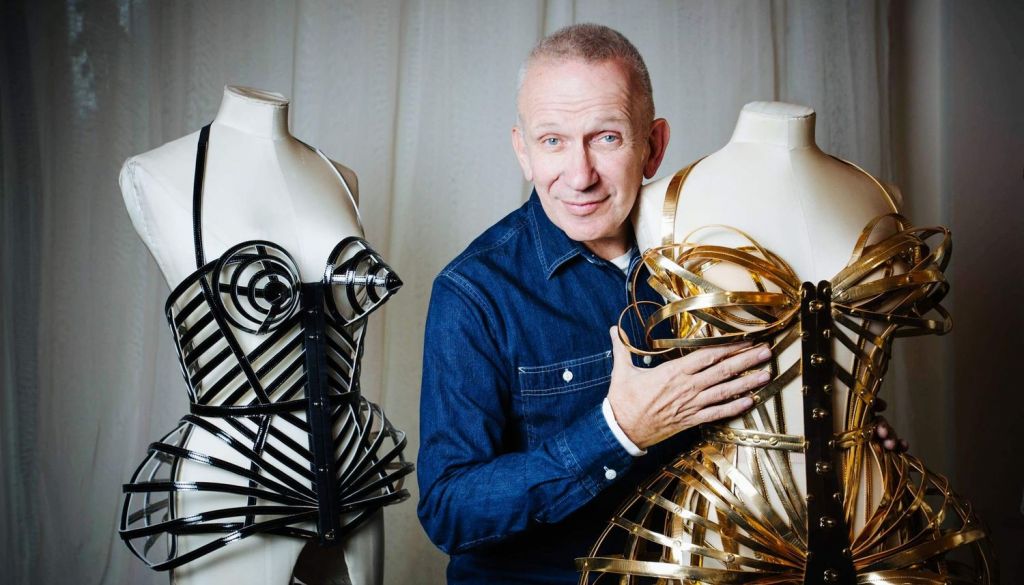Jean Paul Gaultier is known for his extravagant and unconventional style and for bringing punk to Paris. The Frenchman effectively introduced high-street and nightclub-esque couture to the main stages of fashion, allowing alternative culture and style to earn their spot in the mainstream fashion space. Pop culture luminaries such as Madonna and Dita Von Teese were muses to Gaultier, outfitting them with daring corsets and cone bras. Dubbed fashion’s enfant terrible, he consistently defied conventional norms, dressing his models in daring attire like cone bras, mimicking pubic hair, and experimenting with deconstructed undergarments, tin cans, and stitching clothes on top of clothes.
In an interview with I-D, when asked how Paris responded to the punk attitude he infused into the fashion scene, Gaultier said, «Ah, nobody liked it,» with a smile. But Gaultier’s goal wasn’t to please; his goal was to capture the spirit of the cultural zeitgeist through clothing.
In the same interview with I-D, he said that when he first worked in the industry, he faced a «frontier» that asked him to follow the lead of what others had done. Still, Gaultier retorted that expectation as he wanted to express the spirit of others through clothes truly.
«I saw the unjust imbalance of the sexes, and I saw strong and clever women and wanted to express that,» said Gaultier.
During his formative years in Paris, he surreptitiously explored his grandmother’s wardrobe, drawing inspiration from its contents. Enthralled by her corsets, Gaultier embarked on his fashion odyssey. He delved into fashion magazines and immersed himself in the 1960s fashion milieu. By thirteen, he had crafted a collection for his mother and grandmother. Witnessing the rise of «rebellious» trends such as bell bottoms and mini skirts in the 1960s, Gaultier observed fashion’s transition from the conservative ’50s aesthetic to one championing individuality, freedom, and hippie culture. Pioneers like Yves Saint Laurent, Emilio Pucci, and Halston propelled this liberating style-forward, with Gaultier acknowledging YSL as a key influence during his emergence as a designer in the 1970s.
Lacking any formal training, 18-year-old Jean Paul Gaultier distributed his sketches to various French designers. Impressed by his talent, Pierre Cardin enlisted him as an assistant in 1970, marking Gaultier’s initial foray into professional tutelage.
In his early years, while living in Paris, he would tiptoe around his grandmother’s closet, gaining inspiration from her wardrobe. Awestruck by her corsets in particular, Gaultier set out on his journey toward fashion. He began reading fashion magazines and immersing himself in 1960s fashion culture. By thirteen, he created a collection for his mother and grandmother. With bell bottoms, mini skirts, and other «rebellious» fashions rising in popularity then, Gaultier watched fashion shift from the traditional ’50s style to one celebrating individuality, liberation, and hippie culture. Designers like Yves Saint Laurent, Emilio Pucci, and Halston embraced and propelled the freedom-infused style. Gaultier cited YSL as one of his primary inspirations during his rise as a designer in the 1970s.
After a year of working under Cardin, Gaultier took a one-year hiatus to work with Jean Patou. Once returning to Cardin, he identified differences in both designers’ work and began developing an ethos for his own designs. In 1976, he showed his first collection, alongside his romantic and business partner Francis Menuge, in Paris. From his first show on, Gaultier established himself as unconventional, distinctive, and groundbreaking until he eventually launched his own fashion house in 1983. His designs took eccentric to the next level. For years, runways filled with exaggerated bodices, anarchic layering, and exaggerated shaping were the standard for Gaultier. And he never lost sight of his original inspiration: the corset. Many designs incorporated the outdated corset and modernized them. Gaultier redefined the corset as a symbol of female liberation and embracing of femininity.
In 1985, Gaultier debuted his Et Dieu Créa l’Homme (And God Created Man) collection with skirts at the forefront. Male models donned a pant and wrap combo that emulated a skirt in Gaultier’s first introduction to blurring gender lines. He rooted this choice in ancient history and the skirt’s symbolism of masculinity and power, but in 1985, that meant questioning the current symbolism of skirts.







